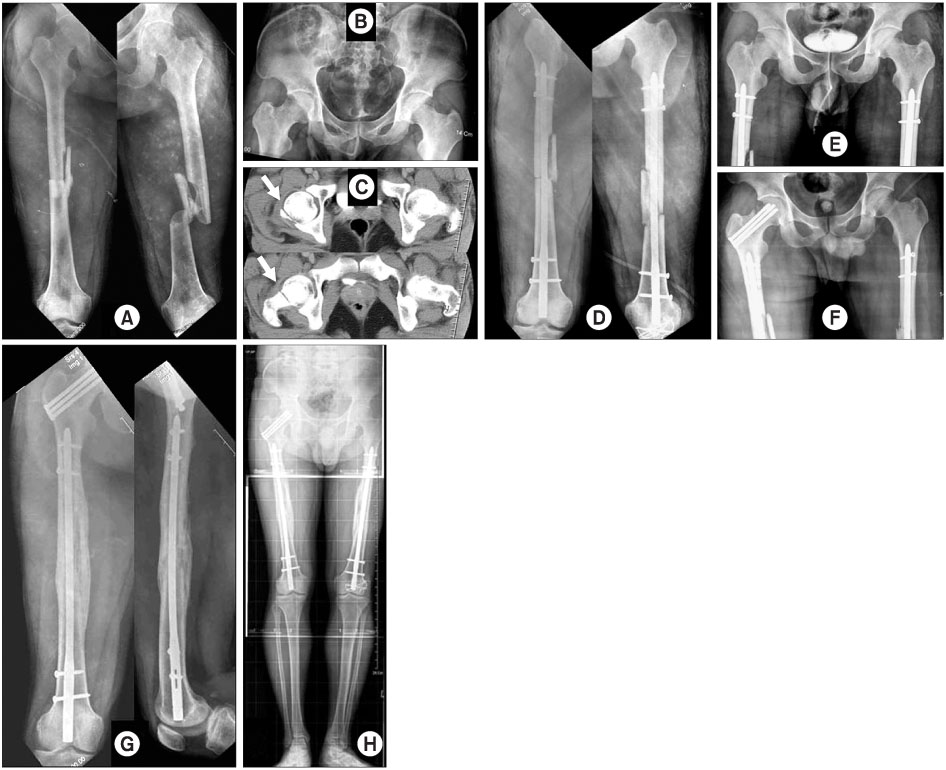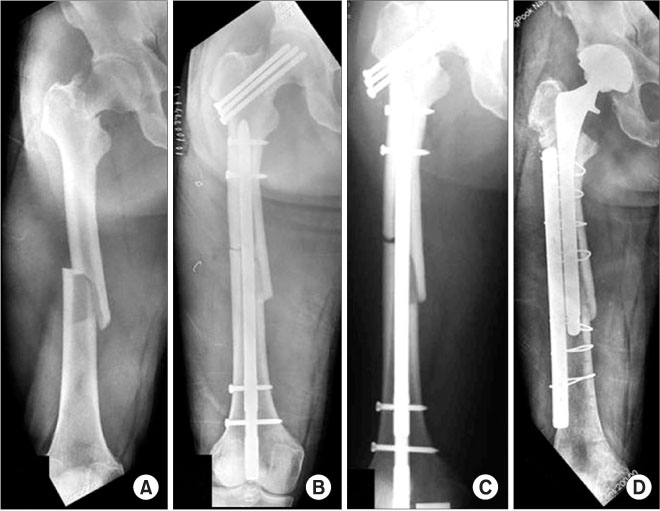J Korean Orthop Assoc.
2007 Jun;42(3):380-385. 10.4055/jkoa.2007.42.3.380.
Retrograde Intramedullary Nailing for the Treatment of Ipsilateral Femoral Shaft and Neck Fracture
- Affiliations
-
- 1Department of Orthopedic Surgery, Kyungpook National University Hospital, Deaegu, Korea. cwoh@knu.ac.kr
- 2Department of Orthopedic Surgery, Guro Hospital, Korea University, Seoul, Korea.
- KMID: 2186564
- DOI: http://doi.org/10.4055/jkoa.2007.42.3.380
Abstract
-
PURPOSE: To evaluate the results of the operative method for ipsilateral femoral shaft and neck fractures using retrograde nailing technique.
MATERIALS AND METHODS
Seventeen fractures (sixteen patients), followed-up more than 1 year, were included in this study. There were 14 men and 2 women, and the mean age was 44 years-old. According to the Winquist-Hansen classification, type II was most common with 11 cases. In femoral neck fractures, type B was most common with 13 cases according to AO-OTA classification and 6 of them were type II in Garden stage. After retrograde nailing of femoral shaft fractures, neck fractures were fixed by cannulated screw or dynamic hip screw.
RESULTS
The average time for union of shaft fractures was 27.3 (14-60) weeks. Nonunion occurred in five patients, who required bone grafts or changes of fixation. The average time for union of neck fractures was 11 (8-12) weeks. All united, except for one case of nonunion with avascuar necrosis, which was a Garden stage IV fracture. Functional results using Friedman-Wyman criteria were good in 16 cases, and fair in one. The only fair result was nonunion of the femoral neck, which had the joint arthroplasty.
CONCLUSION
Although the union rate of femoral shaft must be improved, retrograde nailing can provide an easy fixation and a favorable result for ipsilateral femoral neck fractures.
MeSH Terms
Figure
Reference
-
1. Alho A. Concurrent ipsilateral fractures of the hip and femoral shaft: a meta-analysis of 659 cases. Acta Orthop Scand. 1996. 67:19–28.2. Bucholz RW, Rathjen K. Concomitant ipsilateral fractures of the hip and femur treated with interlocking nails. Orthopedics. 1985. 8:1402–1406.
Article3. Casey MJ, Chapman MW. Ipsilateral concomitant fractures of the hip and femoral shaft. J Bone Joint Surg Am. 1979. 61:503–509.
Article4. Chen CH, Chen TB, Cheng YM, Chang JK, Lin SY, Hung SH. Ipsilateral fractures of the femoral neck and shaft. Injury. 2000. 31:719–722.
Article5. Friedman RJ, Wyman ET Jr. Ipsilateral hip and femoral shaft fractures. Clin Orthop Relat Res. 1986. 208:188–194.
Article6. Gustilo RB, Anderson JT. Prevention of infection in the treatment of one thousand and twenty-five open fractures of long bones: retrospective and prospective analyses. J Bone Joint Surg Am. 1976. 58:453–458.7. Hansen ST, Winquist RA. Closed intramedullary nailing of the femur. Kuntscher technique with reaming. Clin Orthop Relat Res. 1979. 138:56–61.8. Jain P, Maini L, Mishra P, Upadhyay A, Agarwal A. Cephalomedullary interlocked nail for ipsilateral hip and femoral shaft fractures. Injury. 2004. 35:1031–1038.
Article9. Kang S, McAndrew MP, Johnson KD. The reconstruction locked nail for complex fractures of the proximal femur. J Orthop Trauma. 1995. 9:453–463.
Article10. Kim SJ, Oh CW, Ihn JC, et al. Retrograde intramedullary nail for femoral shaft fracture with limited indications. J Korean Fracture Soc. 2003. 16:45–51.
Article11. Leung KS, So WS, Lam TP, Leung PC. Treatment of ipsilateral femoral shaft fractures and hip fractures. Injury. 1993. 24:41–45.
Article12. Oh CW, Kim SY, Kyung HS, et al. Difficulties in the treatment for ipsilateral concomitent femoral neck . J Korean Fracture Soc. 2001. 14:152–158.
Article13. Orthopaedic Trauma Association Committee for Coding and Classification. Fracture and dislocation compendium. J Orthop Trauma. 1996. 10:Suppl 1. S1–S153.14. Swiontkowski MF, Hansen ST, Kellam J. Ipsilateral fractures of the femoral neck and shaft. A treatment protocol. J Bone Joint Surg Am. 1984. 66:260–268.
Article15. Watson JT, Moed BR. Ipsilateral femoral neck and shaft fractures. complications and their treatment. Clin Orthop Relat Res. 2002. 399:78–86.16. Wiss DA, Sima W, Brien WW. Ipsilateral fractures of the femoral neck and shaft. J Orthop Trauma. 1992. 6:159–166.
Article17. Wolinsky PR, Johnson KD. Ipsilateral femoral neck and shaft fractures. Clin Orthop Relat Res. 1995. 318:81–90.18. Wu CC, Shih CH. Ipsilateral femoral neck and shaft fractures. Retrospective study of 33 cases. Acta Orthop Scand. 1991. 62:346–351.
Article19. Yang KH, Han DY, Park HW, Kang HJ, Park JH. Fracture of the ipsilateral neck of the femur in shaft nailing. The role of CT in diagnosis. J Bone Joint Surg Br. 1998. 80:673–678.
- Full Text Links
- Actions
-
Cited
- CITED
-
- Close
- Share
- Similar articles
-
- Treatment of Distal Femoral Shaft and Supracondylar Fracture with aRetrograde Intramedullary Nailing
- Fracture of Femur Neck Associated with Technical Errors in Closed Intramedullary Nailing of the Femur
- Value of Preoperative Bone Scan in Evaluation of Femur Shaft Fracture
- Surgical Treatment of Ipsilateral Multi-Level Femoral Fracture Treated Using Antegrade Intramedullary Nail
- Comparison of Operative Methods between Retrograde and Antegrade Nailing for Ipsilateral Femoral Shaft and Neck Fracture



